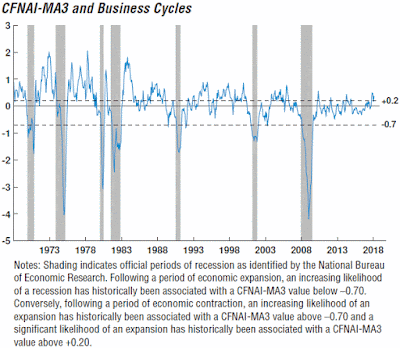Consumer Sentiment: Final Result for March 2018
Predicted: 102.0
Actual: 101.4
- Change from Previous Month: +1.7051% (+1.7 points)
- Change from 12 Months Previous: +4.644% (+4.5 points)
=========
Previous Month's Final ICS Reading: 99.7
=========
From today's report:
"...Consumer sentiment at month's end was marginally below the mid-month reading due to uncertainty about the impact of the proposed trade tariffs. The Sentiment Index, however, still reached the highest level since 2004, and the Current Conditions Index set a new all-time peak. Importantly, all of the March gain in the Sentiment Index was among households with incomes in the bottom third (+14.1); those in the middle third were unchanged, while the Index fell among households in the top third (-5.6). Households with incomes in the top third cited significantly greater concerns with government economic policies than last month, especially trade policies, with net references falling from +31 to just +1, offsetting their positive reactions to tax policies.
The consensus expectation among consumers is that interest rates will increase in the foreseeable future. While consumers view the current level of interest rates as still relatively low, they understand that interest rate hikes are intended to dampen the future pace of economic growth. Their reaction will both emphasize borrowing-in-advance of those expected increases as well as heighten their precautionary savings motives. The trade-off between spending and saving will crucially depend on the pace of future interest rate hikes compared with the pace of income growth. It is likely that income growth will initially dominate, tilting consumers' motives more toward spending than saving.
Overall, the data are consistent with a growth rate of 2.6% in consumption from mid-2018 to mid-2019..."
=========
The ICS is derived from the following five survey questions:
- "We are interested in how people are getting along financially these days. Would you say that you (and your family living there) are better off or worse off financially than you were a year ago?"
- "Now looking ahead, do you think that a year from now you (and your family living there) will be better off financially, or worse off, or just about the same as now?"
- "Now turning to business conditions in the country as a whole, do you think that during the next twelve months we'll have good times financially, or bad times, or what?"
- "Looking ahead, which would you say is more likely: that in the country as a whole we'll have continuous good times during the next five years or so, or that we will have periods of widespread unemployment or depression, or what?"
- "About the big things people buy for their homes, such as furniture, a refrigerator, stove, television, and things like that. Generally speaking, do you think now is a good or bad time for people to buy major household items?"
- Click here for more on how the ICS is calculated.
=========
The ICS uses a 1966 baseline, i.e. for 1966, the ICS = 100. So any number that is below the 1966 baseline of 100 means that the folks who were polled recently aren't as optimistic about the U.S. economy as the sample that was polled back in 1966.
The ICS is similar to the Consumer Confidence Index in that they both measure consumer attitudes and offer valuable insight into consumer spending.
=========
The "predicted" figure is what economists were expecting, while the "actual" is the true or real figure.
=========
Labels: consumer_sentiment, consumers, soft_data
|
--> www.FedPrimeRate.com Privacy Policy <--
CLICK HERE to JUMP to the TOP of THIS PAGE > SITEMAP < |














